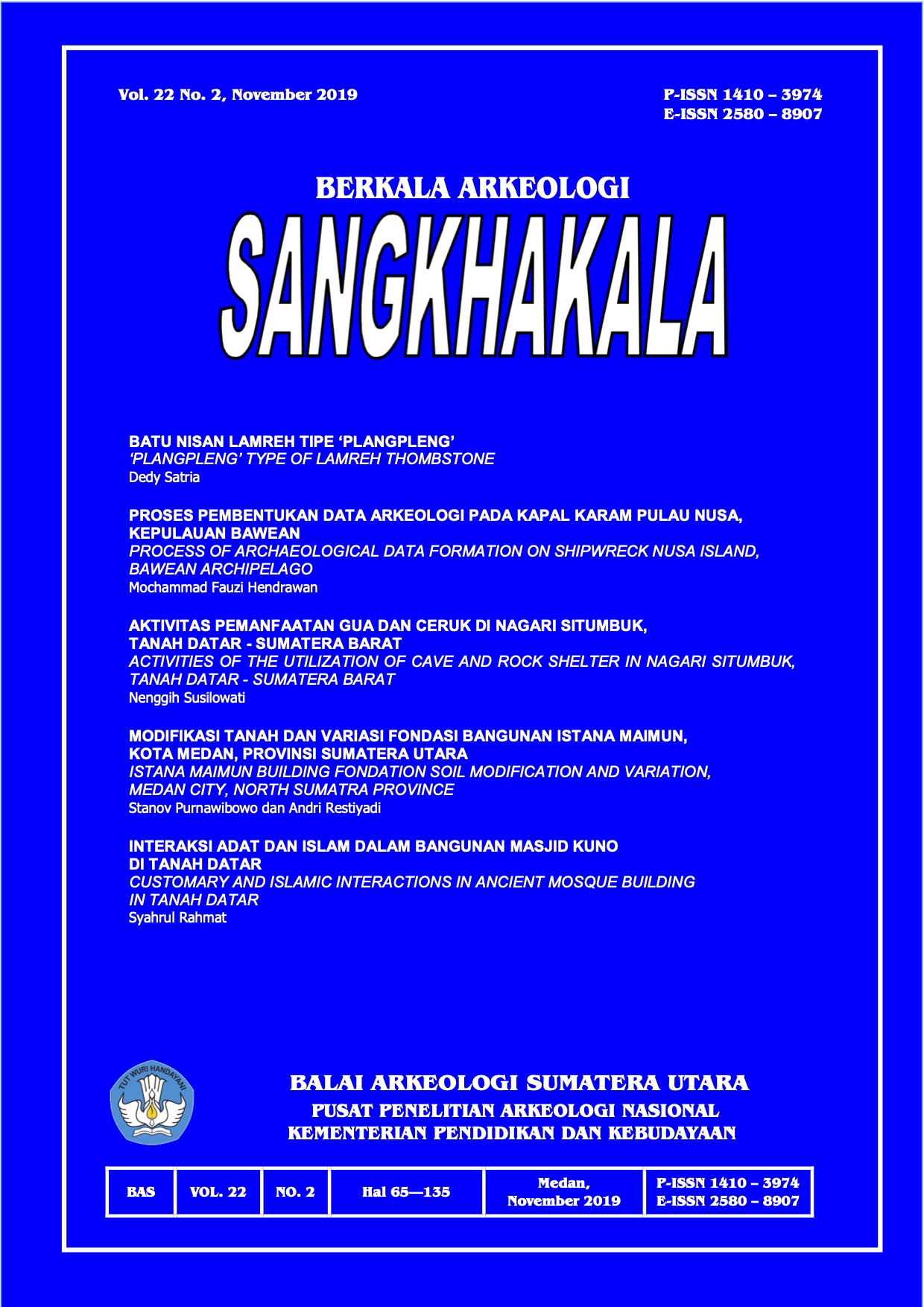BATU NISAN LAMREH TIPE ‘PLANGPLENG’
Main Article Content
Abstract
Plangpleng type tombstone is a very distinctive shape. Sculpture style is the main characteristic of this type of tombstone. That makes it different from other tombstones in Lamreh. Forms of local and foreign motifs from different cultural backgrounds and belief systems. This is a character that reflects a 'mixed' society at the beginning of the development of Islam in Aceh Besar and Banda Aceh. This tombstone is a very important marker as the initial evidence of the presence of Muslim communities along the coast of Aceh Besar and Banda Aceh. As an art object, it has been a human work of the past, and is evidence of the culmination of the achievement of cultural development in an ancient society in Aceh Besar known as the 'Lamuri community’.
Downloads
Article Details
References
Al-Faruqi, Ismail R., and Lois Lamnya Al-Faruqi. 2003. Atlas Budaya Islam Manjelajah Khasanah Peradaban Gemilang, Ornamen Dalam Seni Islam. Bandung: Mizan.
Ambary, Hasan Muarif. 1996. Aspek-Aspek Arkeologi Indonesia No. 19: Makam-Makam Islam Di Aceh. Jakarta: Pusat Penelitian Arkeologi Nasional.
Guillot, Claude. 2008. Les Monuments Foneraires et l’Histoire Du Sultananate de Pase a Sumatera. Cahierd’Archipel. Paris: Association Archipel.
Ibn Bathuthah, Muhammad bin Abdullah. 2009. Rihlah Ibnu Bathuthah, Memoar Perjalanan Keliling Dunia Di Abad Pertengahan. Pertama. Jakarta: Pustaka Al-Kautsar.
Iskandar, Teuku. 1978. Hikayat Aceh (Kisah Kepahlawanan Sultan Iskandar Muda). Aceh: Proyek Rehabilitasi dan Perluasan Museum Daerah Istimewa Aceh.
Lambourn, Elizabeth. 2004. “The Formation of the Batu Aceh Tradition in Fifteenth-Century Samudera-Pasai.” In Indonesia and The Malay World, 211–48. Leicester: University of Leicester.
Lee, Risha. 2009. “Rethinking Community: The Indic Carvings of Quanzhou.” In Nagapattinam to Suvarnadwipa, Reflection on the Chola Naval Expedition to Southeast Asia, edited by Hermman Kulke, K. Kesavapany, and Vijay Sakhuja, 271–91. Singapore: Institute of Southeast Asian Studies.
Montana, Suwedi. 1997. “Nouvelles Donne´es Sur Les Royaumes de Lamuri et Barat.” Archipel, no. 53: 85–95.
Satria, Dedy. 2014. “Jenis Batu Nisan Tipe ‘Batu Pasai’ Dan Plangpleng (Kelompok Pemakaman Kuno Dari Pango Bagian Selatan, Ulee Kareng, Banda Aceh.” Arabesk XVI (1): 1–48.
———. 2016. “Jenis Batu Nisan Tipe ‘Batu Pasai’ Dan Plangpleng (Kelompok Pemakaman Kuno Dari Pango Bagian Selatan, Ulee Kareng, Banda Aceh.” Arabesk 14 (1): 1–27.
Subbarayalu, Y. 2009. “Anjuvvannam: A Maritime Trade Guild of Medieval Times.” In Nagapattinam to Suvarnadwipa, Reflection on the Chola Naval Expedition to Southeast Asia, 158–68. Singapore: Institute of Southeast Asian Studies.
———. 2015. “Sebuah Prasasti Perkumpulan Pedagang Tamil Di Neusu, Aceh.” In Barus Negeri Kamper, 529–34. Jakarta: Kepustakaan Populer Gramedia-EFEO-Pusat Penelitian Arkeologi.
Suprayitno. 2011. “Evidence of The Beginning of Islam in Sumatera: Study on the Acehnese Tombstone.” Tawarikh 2 (2): 125–27.
Wolters, O.W. 2011. Kemaharajaan Maritim Sriwijaya Dan Perdagangan Dunia Abad III-Abad VII. Jakarta: Komunitas Bambu.
Yatim, Othman M. 1988. Batu Aceh, Early Islamic Gravestones in Peninsular Malaysia. Kuala Lumpur: Kuala Lumpur: Museum Association of Malaysia c/o Muzium Negara.
Yatim, Othman M, and Abdul Halin Nasir. 1990. Epigrafi Islam Terawal Di Nusantara. Selangor: Percetakan Dewan Bahasa dan Pustaka.


